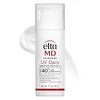What's inside
What's inside
 Key Ingredients
Key Ingredients

 Benefits
Benefits

 Concerns
Concerns

 Ingredients Side-by-side
Ingredients Side-by-side

Benzophenone-3 5%
UV AbsorberEthylhexyl Salicylate 5%
UV AbsorberHomosalate 5%
Skin ConditioningButyl Methoxydibenzoylmethane 3%
UV AbsorberOctocrylene 2.7%
UV AbsorberWater
Skin ConditioningMethyl Trimethicone
Skin ConditioningButylene Glycol
HumectantButyloctyl Salicylate
Skin ConditioningNeopentyl Glycol Diheptanoate
EmollientButyrospermum Parkii Butter
Skin ConditioningPEG-100 Stearate
Silica
AbrasiveDipentaerythrityl Tri-Polyhydroxystearate
EmollientLauryl PEG-9 Polydimethylsiloxyethyl Dimethicone
Skin ConditioningDimethicone
EmollientGlyceryl Stearate
EmollientLaurdimonium Hydroxypropyl Hydrolyzed Soy Protein
Rosmarinus Officinalis Extract
AntimicrobialPerilla Ocymoides Leaf Extract
TonicPlankton Extract
Skin ConditioningCaffeine
Skin ConditioningPotassium Cetyl Phosphate
EmulsifyingSucrose
HumectantStyrene/Acrylates Copolymer
C30-38 Olefin/Isopropyl Maleate/Ma Copolymer
EmulsifyingCetyl Alcohol
EmollientVp/Eicosene Copolymer
Ethylhexylglycerin
Skin ConditioningAmmonium Acryloyldimethyltaurate/Vp Copolymer
PEG-8 Laurate
EmulsifyingSodium Rna
Skin ConditioningLecithin
EmollientPropyl Gallate
AntioxidantArginine Ferulate
Skin ConditioningTocopheryl Acetate
AntioxidantCaprylyl Glycol
EmollientAscorbyl Tocopheryl Maleate
AntioxidantStearic Acid
CleansingXanthan Gum
EmulsifyingHexylene Glycol
EmulsifyingNordihydroguaiaretic Acid
AntioxidantDisodium EDTA
Phenoxyethanol
PreservativeMica
Cosmetic ColorantSodium Dehydroacetate
PreservativeBenzophenone-3 5%, Ethylhexyl Salicylate 5%, Homosalate 5%, Butyl Methoxydibenzoylmethane 3%, Octocrylene 2.7%, Water, Methyl Trimethicone, Butylene Glycol, Butyloctyl Salicylate, Neopentyl Glycol Diheptanoate, Butyrospermum Parkii Butter, PEG-100 Stearate, Silica, Dipentaerythrityl Tri-Polyhydroxystearate, Lauryl PEG-9 Polydimethylsiloxyethyl Dimethicone, Dimethicone, Glyceryl Stearate, Laurdimonium Hydroxypropyl Hydrolyzed Soy Protein, Rosmarinus Officinalis Extract, Perilla Ocymoides Leaf Extract, Plankton Extract, Caffeine, Potassium Cetyl Phosphate, Sucrose, Styrene/Acrylates Copolymer, C30-38 Olefin/Isopropyl Maleate/Ma Copolymer, Cetyl Alcohol, Vp/Eicosene Copolymer, Ethylhexylglycerin, Ammonium Acryloyldimethyltaurate/Vp Copolymer, PEG-8 Laurate, Sodium Rna, Lecithin, Propyl Gallate, Arginine Ferulate, Tocopheryl Acetate, Caprylyl Glycol, Ascorbyl Tocopheryl Maleate, Stearic Acid, Xanthan Gum, Hexylene Glycol, Nordihydroguaiaretic Acid, Disodium EDTA, Phenoxyethanol, Mica, Sodium Dehydroacetate
Zinc Oxide 9%
Cosmetic ColorantEthylhexyl Methoxycinnamate 7.5%
UV AbsorberWater
Skin ConditioningPetrolatum
EmollientIsopropyl Palmitate
EmollientCetearyl Glucoside
EmulsifyingDimethicone
EmollientHydroxyethyl Acrylate/Sodium Acryloyldimethyl Taurate Copolymer
Emulsion StabilisingPolyisobutene
PEG-7 Trimethylolpropane Coconut Ether
EmulsifyingSodium Hyaluronate
HumectantTocopheryl Acetate
AntioxidantPolyether-1
Citric Acid
BufferingOleth-3 Phosphate
Phenoxyethanol
PreservativeButylene Glycol
HumectantIodopropynyl Butylcarbamate
PreservativeTriethoxycaprylylsilane
Zinc Oxide 9%, Ethylhexyl Methoxycinnamate 7.5%, Water, Petrolatum, Isopropyl Palmitate, Cetearyl Glucoside, Dimethicone, Hydroxyethyl Acrylate/Sodium Acryloyldimethyl Taurate Copolymer, Polyisobutene, PEG-7 Trimethylolpropane Coconut Ether, Sodium Hyaluronate, Tocopheryl Acetate, Polyether-1, Citric Acid, Oleth-3 Phosphate, Phenoxyethanol, Butylene Glycol, Iodopropynyl Butylcarbamate, Triethoxycaprylylsilane
 Reviews
Reviews

Ingredients Explained
These ingredients are found in both products.
Ingredients higher up in an ingredient list are typically present in a larger amount.
Butylene Glycol (or BG) is used within cosmetic products for a few different reasons:
Overall, Butylene Glycol is a safe and well-rounded ingredient that works well with other ingredients.
Though this ingredient works well with most skin types, some people with sensitive skin may experience a reaction such as allergic rashes, closed comedones, or itchiness.
Learn more about Butylene GlycolDimethicone is a type of synthetic silicone created from natural materials such as quartz.
What it does:
Dimethicone comes in different viscosities:
Depending on the viscosity, dimethicone has different properties.
Ingredients lists don't always show which type is used, so we recommend reaching out to the brand if you have questions about the viscosity.
This ingredient is unlikely to cause irritation because it does not get absorbed into skin. However, people with silicone allergies should be careful about using this ingredient.
Note: Dimethicone may contribute to pilling. This is because it is not oil or water soluble, so pilling may occur when layered with products. When mixed with heavy oils in a formula, the outcome is also quite greasy.
Learn more about DimethiconePhenoxyethanol is a preservative that has germicide, antimicrobial, and aromatic properties. Studies show that phenoxyethanol can prevent microbial growth. By itself, it has a scent that is similar to that of a rose.
It's often used in formulations along with Caprylyl Glycol to preserve the shelf life of products.
Tocopheryl Acetate is AKA Vitamin E. It is an antioxidant and protects your skin from free radicals. Free radicals damage the skin by breaking down collagen.
One study found using Tocopheryl Acetate with Vitamin C decreased the number of sunburned cells.
Tocopheryl Acetate is commonly found in both skincare and dietary supplements.
Learn more about Tocopheryl AcetateWater. It's the most common cosmetic ingredient of all. You'll usually see it at the top of ingredient lists, meaning that it makes up the largest part of the product.
So why is it so popular? Water most often acts as a solvent - this means that it helps dissolve other ingredients into the formulation.
You'll also recognize water as that liquid we all need to stay alive. If you see this, drink a glass of water. Stay hydrated!
Learn more about Water